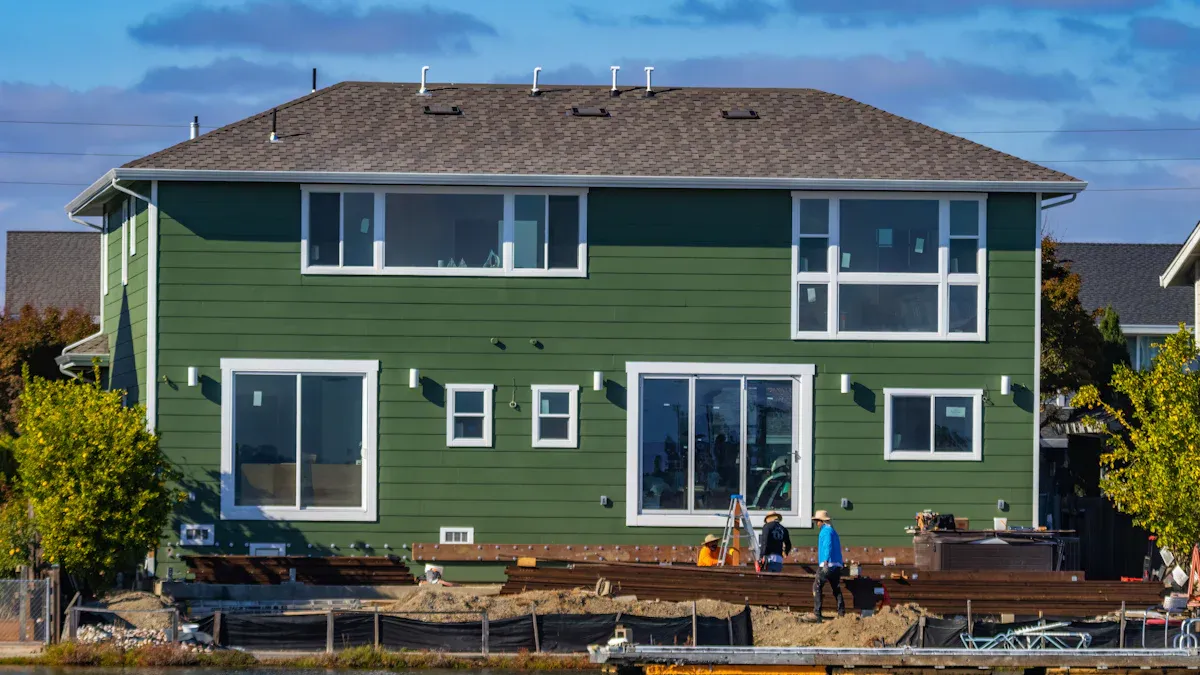
01 Nov Expert Advice on Choosing Fiber Cement Board for Exterior Wall Projects
Table of Contents
Choosing the right fiber cement board for exterior walls helps your home stay strong and look nice for a long time. You should use expert advice to check the board thickness. Look for trusted certifications. Make sure your choice works well in your weather. Many people pick fiber cement board for exterior walls because it is strong, keeps out water, and is safe from fire. Here is how it compares to other materials:
Percentage Used | |
|---|---|
Stucco | 26.8% |
Vinyl Siding | 25.6% |
Fiber Cement Siding | 21.7% |
Brick or Brick Veneer | 18.5% |
Wood or Wood Products | 5.1% |
Stone or Rock | 1.2% |
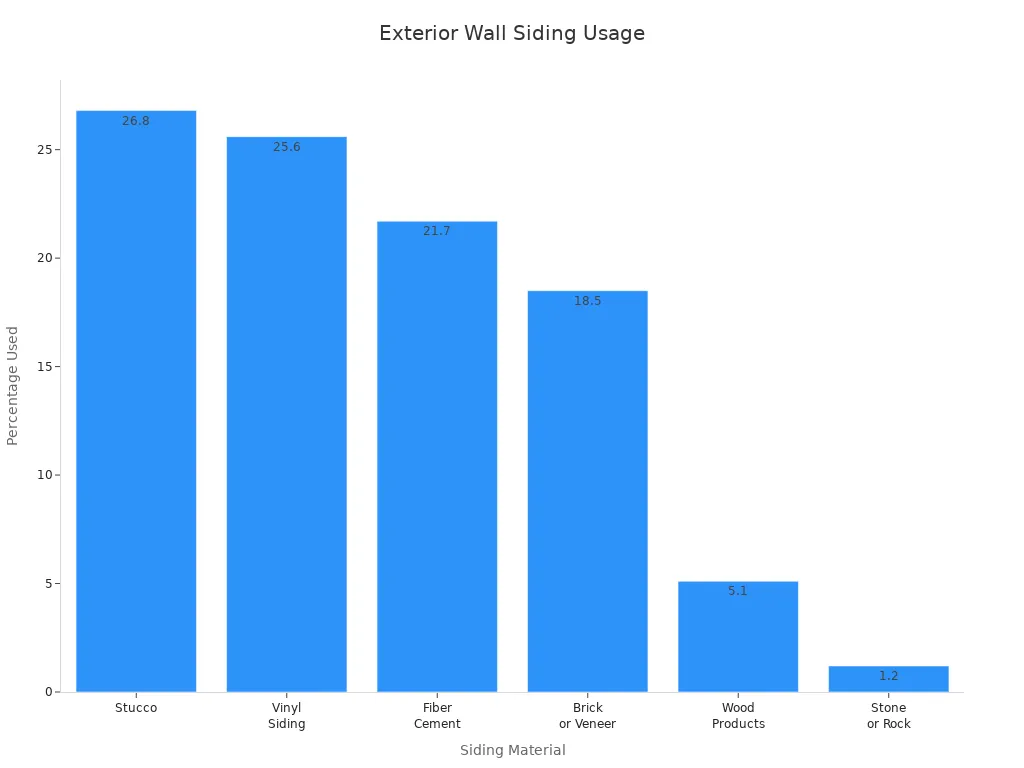
When you follow expert advice, your home gets the right mix of style and strength. Your home needs materials that stop rain, wind, and bugs. Expert advice helps you have less work to do and feel safe. This is true if you live near the ocean or in a dry place. If you want your home to look good and stay safe, expert advice helps you make a smart choice regarding fiber cement board for exterior walls.
Key Takeaways
Pick the right thickness of fiber cement board for your weather. Thicker boards protect better from strong weather.
Check for trusted certifications when you pick fiber cement board. Certified boards mean your home is safe and good quality.
Fiber cement board does not need much care. Clean it once a year. Repaint it every 10 to 15 years to keep it nice.
Think about the design choices you have. Fiber cement board comes in many styles and colors. You can match it to your home’s look.
Buy fiber cement board for long-lasting value. It can last over 50 years. It needs fewer repairs than other materials.
Fiber Cement Board for Exterior Wall
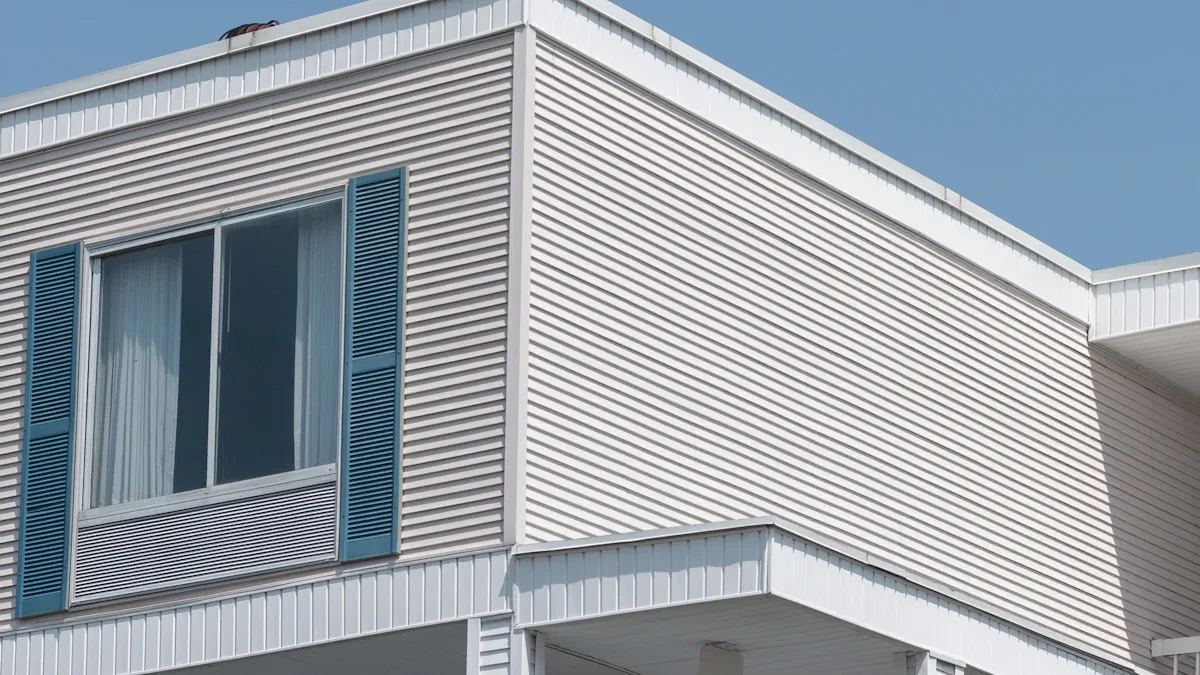
What Is Fiber Cement Board
You might wonder what makes fiber cement board for exterior wall projects so popular. This material combines strength and style for your home. Manufacturers blend Portland cement, natural and synthetic fibers, clay, and other fillers to create a sturdy board. The process starts with smashing scrap cardboard, soaking it in water, and mixing it with cellulose and acrylic fibers. Then, they add cement and other ingredients to form a thick slurry. This mixture gets shaped and cured into boards that you can use for siding or cladding.
Here’s a quick look at what goes into fiber cement board:
Component | Percentage by Weight |
|---|---|
Portland cement binder | 40% – 80% |
Natural/synthetic fibers | 1% – 15% |
Clay | 2% – 15% |
Thickener | 0.03% – 0.5% |
Silica/filler | 10% – 40% |
Nano calcium silicate | 1% – 4% |
Acrylic fibers | 1% – 4% |
Limestone powder | 5% – 20% |
You get a board that’s tough, flexible, and ready to protect your home from the elements.
Key Benefits
When you choose fiber cement board for your exterior wall, you give your home several advantages over other siding options. Let’s break down the main benefits:
Fiber cement siding stands up to harsh weather, including strong sun, freezing cold, heavy rain, and hail. You don’t have to worry about it cracking or peeling.
Your home stays safer because fiber cement board is fire-resistant. You get peace of mind knowing your siding won’t catch fire easily.
Unlike wood siding, fiber cement board does not rot, warp, or get eaten by insects. You spend less time and money on repairs.
Fiber cement siding needs very little maintenance. You usually only need to clean it and repaint every 25 to 30 years.
Installation is easier than stucco. The boards come pre-formed and often include a built-in rainscreen to keep moisture out of your home.
Fiber cement board does not expand or contract much with temperature changes. This means fewer cracks and a longer-lasting finish for your home.
Tip: If you want cladding that lasts and keeps your home looking great, fiber cement board for exterior wall projects is a smart choice.
Design and Style Choices
Profiles and Aesthetics
When you start planning your exterior wall project, you want your home to stand out. Fiber cement board gives you a lot of design options. You can pick from many profiles and surface textures. Some boards look like classic lap siding. Others copy the look of stucco, brick, or even stone. If you like a modern style, you can choose reveal panels with clean lines. You can also find boards that mimic wood grain, which adds warmth and character.
This wide range of design profiles means you can match almost any architectural style. Whether you want a traditional or a modern look, you can find a fiber cement board that fits your vision. The design flexibility helps you achieve the right aesthetics for your home. You can even mix profiles for a unique touch. Think about how the design will work with your windows, doors, and trim. This helps you create aesthetic compatibility across your whole exterior.
Tip: Try to picture how each design profile will look on your home. Ask for samples if you can. This makes it easier to choose the right aesthetic for your project.
Color and Finish
Color and finish play a big role in the design and long-term look of your exterior walls. You can choose from a wide palette of colors. Some people like bold, dark shades. Others prefer soft, light tones. Darker colors do a great job hiding dirt and wear. Lighter shades show grime more easily, so you may need to clean them more often.
Dark shades help your home look fresh longer.
Light colors may need more cleaning to keep their aesthetic appeal.
The color you pick can affect how much heat your walls absorb. This can change how often you need to repaint or clean.
You should clean your siding at least once a year. Use a soft brush and mild soap for tough spots. Stay away from harsh chemicals that could damage the finish. Most fiber cement boards need repainting every 10 to 15 years, depending on your color choice and local weather.
When you think about design, remember that color and finish affect both style and maintenance. The right choices will help your home keep its aesthetics for years.
Durability and Performance
 Enhanced Durability Factors
Enhanced Durability Factors
When you pick fiber cement board for outside walls, you want it to last. The thickness of the board is very important. Thicker boards protect better from hard hits and bad weather. If the board is too thin, it can crack or break. This can happen if something hits it or during storms. Look at this table to see which thickness is best for each use:
Thickness Range | Application |
|---|---|
6mm | Good for inside walls or light jobs |
8mm to 10mm | Works for outside walls in gentle weather |
12mm to 15mm | Best for most outside walls in normal weather |
18mm to 20mm | Great for tough jobs in rough weather |
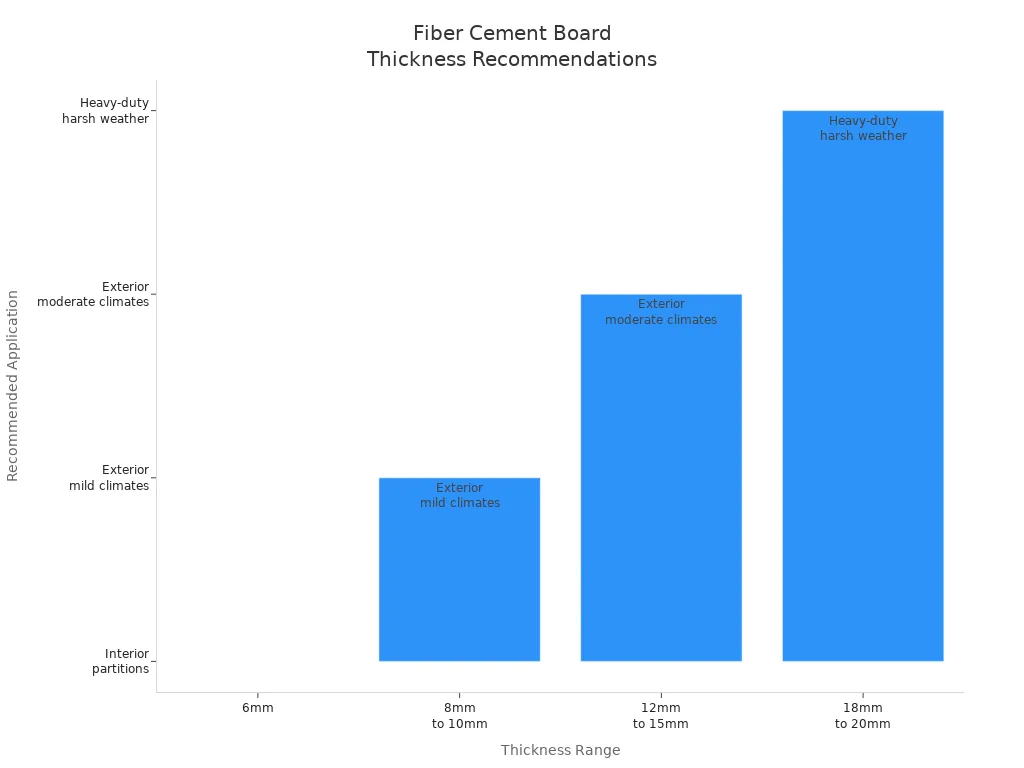
If you live where storms or strong winds happen, use at least 12mm thick board. This helps your walls stay strong and safe. Thicker boards also stop dents and bumps from daily life.
Density is important too. Boards with more density are stronger and last longer. Dense boards keep out water and handle hits better. Here is what you should know:
High-density boards work well in tough places and keep their shape.
These boards do not bend or crack when the weather changes fast.
They protect your walls from hits, so your home stays safe.
For the best results, pick boards with density over 1,200 kg/m³. These boards are harder to damage and help your home stay safe.
Quality matters a lot. Always check for certifications before buying. Certified boards follow strict rules for strength, fire safety, and water resistance. Here is a quick guide to the top certifications:
Certification | Description |
|---|---|
CE12467 | European rule for fiber cement boards, checks strength and fire safety. |
CE14306 | Checks calcium silicate boards for fire safety and insulation. |
GB8624 | Shows boards are A1-grade and do not burn. |
AS-NZS2908 | Follows rules in Australia and New Zealand. |
BS476 | Tests fire safety in the UK. |
Tip: Always ask your seller for proof of certification. Boards with CE and ISO9001 marks are safe and high quality.
Weather and Moisture Resistance
You want your outside walls to handle rain, snow, and wet air. Fiber cement board is good at stopping weather, but not all boards are the same. Boards with more density and less recycled fiber keep out water better. If a board has too much recycled fiber, it can soak up water and get weak.
Boards with lots of recycled fiber take in more water.
After soaking for 96 hours, boards with 50% recycled fiber lost half their strength.
Boards that do not soak up much water last longer and protect your home better.
Pick boards that keep their shape and strength after rain or snow. Strong boards help your home stay safe in bad weather. You can feel sure your walls will not bend, crack, or rot.
Note: For the best weather and water resistance, pick boards with high density and good certifications. This keeps your home strong and dry in any weather.
Fiber cement board protects your home from the outdoors. It is strong, handles hits, and lasts a long time. If you choose the right thickness, density, and certified quality, your outside walls will look nice and stay safe for many years.
Fiber Cement Board Siding in Different Climates
Climate Suitability
You want your house to be strong in any place. Fiber cement board siding works well in many climates. Each climate zone has its own problems for outside walls. Here is how fiber cement board for exterior wall projects helps in each zone:
Climate Zone | Key Challenges |
|---|---|
Hot/Dry | UV stability and thermal insulation |
Mixed-Humid or Marine | Moisture management via cavity drainage |
Cold | Freeze-thaw durability and continuous insulation |
High Wind/Hurricane | Structural strength through mechanical fastening |
WUI/Fire-Prone | Fire resistance and non-combustible materials |
If you live where it is hot and dry, fiber cement board siding does not get ruined by the sun. It also helps keep your house cool. In places that are wet or near the ocean, you need barriers and drains to stop water from getting inside. Cold places need siding that does not crack when it freezes and thaws. If you live where there are strong winds, you need to fasten the siding tightly so it stays on. In places with lots of fires, fiber cement siding is good because it does not burn easily.
Here is a quick chart to help you pick features for your climate:
Climate Type | Key Features |
|---|---|
Humid | Moisture resistance, anti-mold treatments, ventilation, regular cleaning |
Dry | Fire resistance, UV/weather resistance |
Coastal | Resistance to salty air and strong winds |
Cold | Low expansion/contraction, moisture barriers, corrosion-resistant fasteners |
Tip: Pick fiber cement board siding with features that fit your weather. This helps your house last longer and stay safe.
Moisture and Pest Resistance
You want siding that keeps out water, mold, and bugs. Fiber cement board siding is good at stopping these problems. The material does not swell or bend when it gets wet. It does not rot or break down. You can use it in wet rooms inside, but it works best on outside walls.
Fiber cement board siding is made from cement, sand, and cellulose fibers, so it does not rot or let bugs in.
The dense, hard material keeps termites and carpenter ants away.
Mold and mildew cannot grow inside the board. You can wash off any mold on the surface with soap and water.
Fiber cement siding acts like a shield for your house. It blocks water from getting in, so mold and mildew do not grow. If you take care of it, fiber cement board siding can last up to 50 years. You can feel safe knowing your house stays dry and protected.
Note: Choose fiber cement board siding that is good at keeping out water and fits your climate. This will protect your house from bugs, mold, and bad weather for a long time.
Comparing Fiber Cement Board Brands
 Brand Features
Brand Features
There are many fiber cement board brands to pick from. Each brand has special features for different needs. Some brands are best for tough weather. Others give you more styles or longer warranties. Look at this table to see how top brands are different:
Brand | Best For | Key Features | Downside |
|---|---|---|---|
James Hardie | Residential siding, soffits, cladding | ColorPlus Technology, weather-resistant, fireproof, termite-proof | Higher price point |
Nichiha | High-end commercial/residential facades | Wide range of textures, lightweight, superior fade resistance | Limited availability in some areas |
Allura | Budget-friendly siding/backer boards | 50-year warranty, mold/moisture resistant, easy to install | Fewer color options than Hardie |
Cembrit | Modern & sustainable designs | Eco-friendly production, high resistance to frost and UV rays | Less common in North America |
CertainTeed | Residential/light commercial projects | WeatherBoard technology, wide range of pre-finished colors | Slightly heavier than Hardie |
Equitone | Architectural & industrial use | Through-colored panels, customizable sizes, excellent acoustic properties | More expensive, typically commercial |
James Hardie is known for being strong in bad weather. It also keeps out fire and bugs. Nichiha has many textures and is light to carry. Allura is easy to put up and has a long warranty. When you look at brands, think about what matters most for your home and weather.
Tip: Pick a brand with features that fit your project. This helps your home look good and last longer.
Warranty and Support
Warranties and support are important when you buy fiber cement board. You want to know the company will help if something goes wrong. Here is a table showing what top brands offer:
Brand | Warranty Terms | Support Services |
|---|---|---|
James Hardie | 30-year non-prorated warranty; 15-year finish warranty for ColorPlus Technology | |
Nichiha | 30-year limited manufacturer’s warranty | Support available, less detailed |
Allura | 50-year limited warranty | Customer service available |
CertainTeed | Warranty included; claims by phone or online | Easy claim process |
James Hardie gives a strong warranty if you use trained installers. Their team answers questions and helps with problems.
Nichiha and Allura also have long warranties, so you can trust them.
CertainTeed lets you make claims by phone or online, which is easy.
Always read the warranty before you buy. Some brands cover both the board and the work if you use approved installers. Good support means you get help fast if you need it.
Note: A good warranty and helpful support make you feel safe. Choose a brand that stands by its features and helps you when needed.
Installation and Maintenance
Installation Tips
You want your fiber cement board to last and look great. Following installation best practices makes a big difference. Start by planning your work sequence. You should install wall framing, add insulation, rough-in utilities, and then mount the exterior cladding. Always check your framing. Reject any warped studs and snap layout lines for tracks. Secure top and bottom tracks, then install vertical studs and headers. Add horizontal bracing for extra support.
When you move to board installation, use self-tapping screws spaced 200-300mm apart. Keep a 10-15mm edge distance and drill pilot holes a bit smaller than your screws. These steps help your siding stay strong. For cutting, you need the right tools. Use diamond blades or a circular saw with four or six teeth. Fiber-cement shears attach to a drill and make less dust. A jigsaw with a carbide grit blade works for curved cuts. Always work outside and wear a dust mask to protect yourself from silica dust.
Here’s a quick table of tools you’ll need:
Tool/Technique | Description |
|---|---|
Diamond blades | Fast cutting, less dust |
Circular saw | Use special blades for fiber cement |
Fiber-cement shears | Easy to handle, low dust |
Jigsaw | Good for curves |
Layout square | Helps with right-angle cuts |
Protects you from dust and debris |
Stick to installation best practices and you’ll get a smooth, safe finish.
Joint Sealing and Longevity
You want your siding to keep out water and last for years. Joint sealing is key. Seal all cut edges to stop water from getting in. Use proper flashing around windows and doors. Leave enough clearance so the boards don’t touch water for long periods. Make sure there’s space for drainage so moisture can evaporate.
Check your siding often for cracks, gaps, or wear. Fix problems quickly to avoid mold or rot. Replace caulking and seal gaps to keep your fiber cement siding strong. Good installation best practices, like sealing and fastening, help prevent water entry. Studies show that careful installation lowers the risk of mold and rot. Skilled workers and following guidelines make your siding last longer.
Tip: If you want your exterior walls to stay strong, focus on joint sealing and regular checks. This keeps your home safe and looking good.
Cost and Value
Upfront vs. Long-Term Costs
When you look at fiber cement board siding for your home, you might notice the upfront price feels higher than some other options. The average cost for fiber cement siding installation ranges from $5.00 to $13.50 per square foot. This price is close to wood, engineered wood, and insulated vinyl, but it’s usually more than regular vinyl siding. Here’s a quick table to help you compare costs for different project sizes:
Square feet | Cost range |
|---|---|
1,000 | $6,000 to $11,000 |
1,500 | $9,000 to $16,500 |
2,000 | $12,000 to $22,000 |
2,500 | $15,000 to $27,500 |
3,000 | $18,000 to $33,000 |
3,500 | $21,000 to $38,500 |

You might wonder how these costs stack up against other siding materials. Take a look at this table:
Material | Maintenance Frequency | Long-term Cost Implications | |
|---|---|---|---|
$1.00 – $3.00 | Painting every 10-15 years | Lower long-term costs due to durability | |
Vinyl Siding | $0.50 – $1.50 | Minimal maintenance, may fade | Potential replacement costs over time |
Wood Siding | $1.50 – $3.50 | Painting/staining every few years | Higher long-term costs due to regular maintenance |
Aluminum Siding | $0.50 – $2.00 | May require repainting | Costs vary based on condition and age |
Fiber cement board siding needs less maintenance and fewer repairs, so you save money over time. You paint it every 10 to 15 years, while wood siding needs more frequent care.
Value Over Time
Choosing fiber cement board siding gives your home long-term value. You get a product that lasts more than 50 years, while engineered wood siding only lasts 20 to 30 years. Vinyl siding does not last as long as fiber cement board siding. Here’s a quick look:
Siding Type | Lifespan |
|---|---|
Fiber Cement | |
Engineered Wood | 20-30 years |
Vinyl Siding | Less than Fiber Cement |
You get more than just durability. Fiber cement board siding resists fire, rot, and pests. It looks like natural wood, which boosts your home’s curb appeal. You also help the environment because fiber cement boards support green building certifications and improve insulation. This means you save on energy bills and enjoy a quieter home.
Fiber cement board siding stands up to extreme weather and needs little upkeep.
It keeps your home safe and comfortable.
You make a smart investment that pays off for decades.
Tip: If you want siding that gives you long-term value and peace of mind, fiber cement board siding is a smart investment.
When you choose fiber cement board for outside walls, think about what is most important. Check if the board is thick enough. Make sure it can handle water and keep out termites. You can pick boards that are already painted. Fiber cement board siding comes in many styles. It can handle bad weather. You should think about how it looks, how strong it is, and if it works in your weather. This siding fits many houses, but putting it up can be hard. Ask an expert or a store worker for help. Plan your project now so your house stays strong for a long time.
FAQ
How long does fiber cement board siding last?
You can expect fiber cement board siding to last over 50 years. It stands up to weather, pests, and fire. You just need to clean it and repaint every 10 to 15 years to keep it looking fresh.
Can you paint fiber cement board siding?
Yes, you can paint fiber cement board siding. Most boards come pre-primed or pre-painted. If you want a new color, just clean the surface and use high-quality exterior paint. This helps your siding last even longer.
Is fiber cement board siding hard to install?
You can install fiber cement board siding if you have the right tools and follow the instructions. The boards are heavier than vinyl, so you may need help lifting them. Always wear a dust mask when cutting.
Does fiber cement board siding need a lot of maintenance?
Good news! You don’t need to do much. Just wash your siding once a year with soap and water. Check for cracks or gaps and touch up paint as needed. This keeps your home looking great.

 Enhanced Durability Factors
Enhanced Durability Factors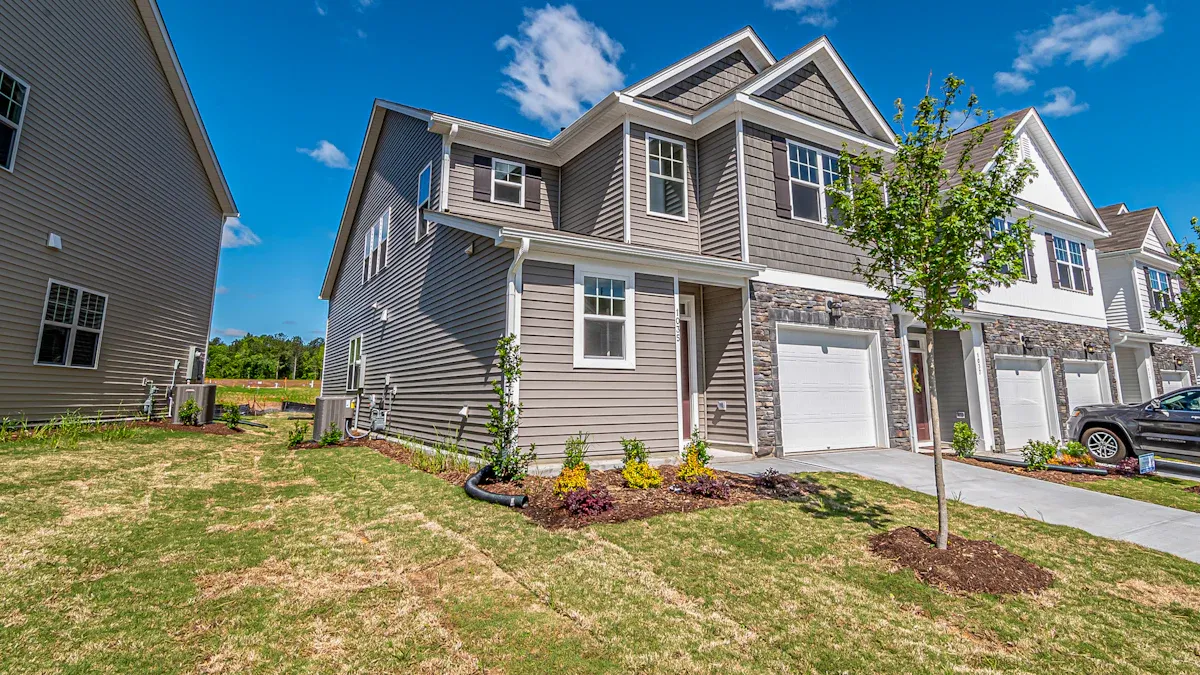 Brand Features
Brand Features